Tramway Depot, Ashton Rd, Denton
In 1882 horse-drawn tramcars were introduced in the Denton area by the Manchester Carriage Co Ltd (details below) but
it was not until towards the end of the 19th century that plans were being made to convert the routes to electric operation.
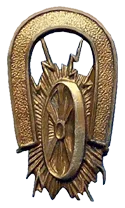
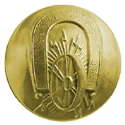 On the 12 Jun 1899 the first electric tramway system in the Manchester area was opened by Oldham, Ashton and Hyde Electric Tramway Ltd,
which was owned by the British Electric Traction Co Ltd whose Registered Office was at Donington House, Norfolk St, Strand, London.
At its peak this company owned, or part-owned, around 50 tramway companies. The origins of this company were with the British Electric Traction (Pioneer) Co Ltd, Company No. 45897, incorporated in 1895.
On the 12 Jun 1899 the first electric tramway system in the Manchester area was opened by Oldham, Ashton and Hyde Electric Tramway Ltd,
which was owned by the British Electric Traction Co Ltd whose Registered Office was at Donington House, Norfolk St, Strand, London.
At its peak this company owned, or part-owned, around 50 tramway companies. The origins of this company were with the British Electric Traction (Pioneer) Co Ltd, Company No. 45897, incorporated in 1895.
During the late 1890s the British Electric Traction Co Ltd began purchasing horse and steam-operated tramways with the intention of converting them to electric traction and simultaneously it was promoting schemes for new electric tramways. In 1897 it registered Oldham, Ashton and Hyde Electric Tramway Ltd to build and operate a fully electric tramway running from Hathershaw, Oldham, through Ashton-under-Lyne and Denton to Hyde. The route largely followed that of an earlier tramway promoted by the Oldham, Ashton and Hyde Tramway Co Ltd, which was intended to be steam operated but never got further than constructing a small amount of track at Ashton-under-Lyne in 1891/2.
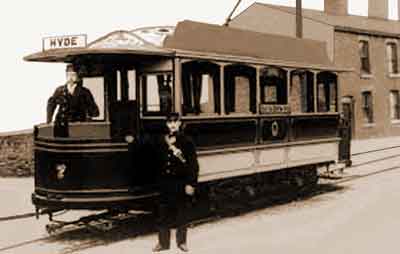
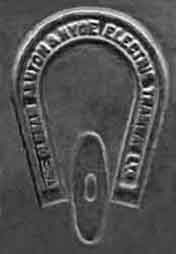
Right: Logo of the Oldham, Ashton and Hyde Electric Tramway Ltd. A magnet and wheel with the company name embossed on the magnet:
THE OLDHAM ASHTON & HYDE ELECTRIC TRAMWAY LTD
There were two electric tramcar routes through Denton and for a while they were unconnected:
The Ashton-under-Lyne, Audenshaw, Denton, Hyde route. This route was first operated by the Oldham, Ashton and Hyde Electric Tramway Ltd and it was open by 1900. Tramcars travelling from Ashton to Hyde turned left at Crown Point, Denton, and vice versa. The Manchester, Gorton, Denton, Haughton Green route, was operated by Manchester Corporation Tramways and it opened on the 1 Jun 1902. Tramcars terminating at Denton stopped on Manchester Rd just short of Crown Point. Tramcars travelling to Haughton Green turned right into Market St, left into Victoria St (Market Place), and then right into Stockport Rd. Tramcars travelling in the opposite direction turned left from Stockport Rd into Albert St (Market Place), right into Market St and then left into Manchester Rd.
In association with the Ashton, Audenshaw, Denton and Hyde route, a tramway depot was built on Ashton Rd, Denton, adjoining the boundary with Audenshaw. As built, this tramway was of single track construction with passing places and outside the depot there were two turnouts so that tramcars leaving the depot could either turn left towards Audenshaw and Ashton or right towards Denton and Hyde.
Concerning the Oldham, Ashton and Hyde Electric Tramway Ltd, Slater's Trade Directories list the following:
1903: M Rathborn, Superintendent; H S Hodson, Secretary.
1909: M Rathborn, Manager; W S Wreathall, Secretary.
1911: Adam Anderson, Superintendent; W S Wreathall, Secretary.
On the 22 Jul 1921 a resolution was passed at a meeting of the Oldham, Ashton and Hyde Electric Tramway Ltd that the company should be voluntarily wound up. The company chairman at this time was E Garcke.
By 1922 the two routes through Denton were still unconnected and it was not until later that tramcars were able to travel between Manchester and Hyde.
Two other tramcar companies operating in the area were the Manchester Carriage Co Ltd and the Manchester, Bury, Rochdale and Oldham Steam Tramways Ltd.
The Manchester Carriage Co Ltd was incorporated in 1865, Company No. 1932C, and in 1901 it was reconstructed and incorporated as the Manchester Carriage and Tramways Co Ltd, Company No. 72244. Initially their tramcars were horse hauled. The Manchester, Bury, Rochdale and Oldham Steam Tramways Ltd was founded in 1883.
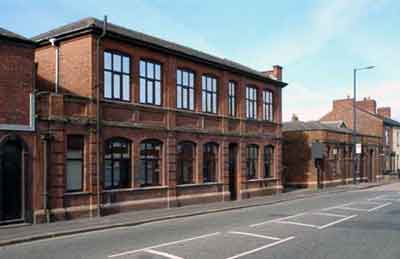
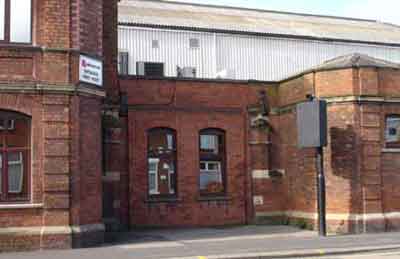
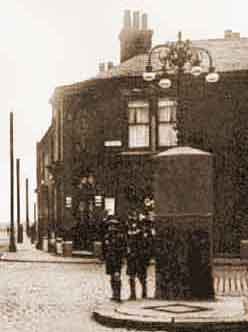
Pillar transformer and street light at the intersection of Denton Rd, Stamford Rd and Guide Ln, Audenshaw, early 20th century.
This transformer was used to supply power to the tramway and it was made by the British Electric Transformer Co of Hayes, Middlesex.
Tramcar Dispute and Riot
In 1900, an industrial dispute occurred at Oldham, Ashton and Hyde Electric Tramway Ltd and by mischance Denton was at the centre of it.
On the 20 Oct 1900, a demonstration was held and a large crowd turned out to watch a procession, which was mainly comprised of men from neighbouring towns.
A group of workers set off to walk from Openshaw, through Denton, to Ashton, where a meeting was to be held in the market place. When the procession reached the Denton Tramway Depot someone threw a stone at a window in the depot. Police were already guarding the building and they made for the man who threw the stone. This caused a mêlee and then a full-scale riot broke out.
More stones were thrown and the police charged the crowd. When people began to be injured a stampede occurred, during which some people were badly crushed. During the riot, fugitives from the police were given refuge in nearby houses.
Williamson Tickets
The Williamson Printing Works was founded by John Williamson in 1835 and it grew into Alfred Williamson Ltd of North Mill Ticket Works, Cotton St East, Ashton-under-Lyne.
The printing works was situated on the corner of Gas St and it was a 4-storey, brick-built mill, 16 bays long on Cotton St East by 4 bays wide on Gas St.
The company printed tickets for horse-drawn tramcars in Ashton, Oldham and Stalybridge and later for tramcar and bus services all over Manchester.
Eventually they printed tickets for tramcar and bus operators throughout Britain.
The company traded until 1985 when it was liquidated.
By 1901 John and Frank Williamson, company proprietors, were resident next door to each other on Taunton Rd, Ashton-under-Lyne. John Williamson married Mary Elizabeth Grayson at St Paul’s Church, Staley, Stalybridge, in 1891 and Frank Williamson married Emma Maria Rothwell at Holy Trinity, Ashton-under-Lyne, in 1896.
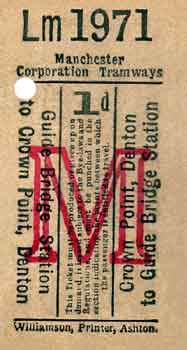
Manchester Corporation Tramways 1d ticket - Guide Bridge Station to Crown Point, Denton.
If the ticket had been punched on the right-hand side it would have been for a journey from Crown Point to Guide Bridge Station.
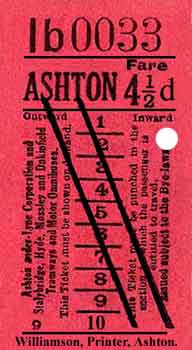
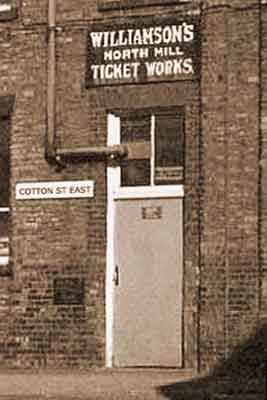
Change in use of the Tramway Depot
After the building had become disused as a tramway depot it was occupied by Bell Brothers (Manchester 1927) Ltd who were water purification engineers.
This company changed the name of the building to Calder Iron Works.
In the same year that the company was incorporated, they introduced a calculating instrument known as a 'hydraulic slide rule'. This was used in mathematical calculations relating to the rate of flow of liquids in pipes using parameters such as pipe diameter, pipe gradient and liquid velocity in feet per second.
An early project that the company was involved with was Watergrove Reservoir, Rochdale, which opened on the 6 Apr 1938. The company supplied the water filtering equipment. A later project was in 1952 when they supplied filtering equipment for Rivington Reservoir (aka Sheephouse Reservoir) near Bolton.
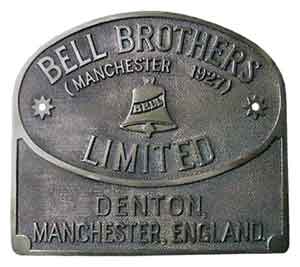
Worksplate.
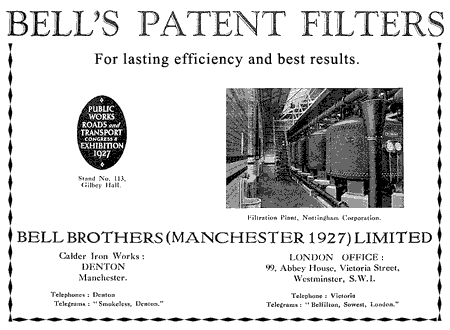
Advertisement.
